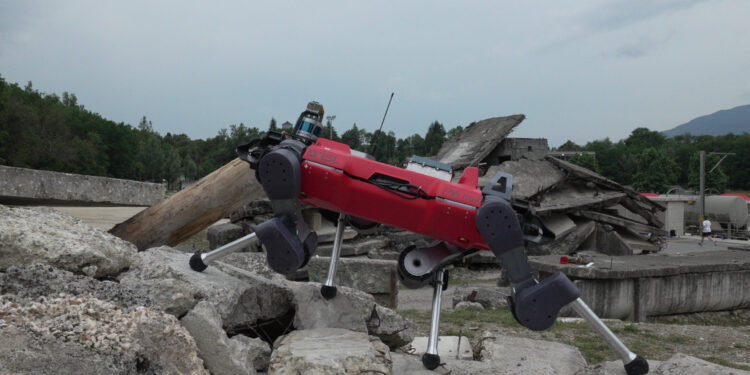Real-world deployment in search and rescue scenarios. Credits: Fabian Jenelten, Junzhe He, Farbod Farshidian and Marco Hutter
A team of robotics engineers from the Robotic Systems Lab in Switzerland has developed a hybrid control architecture that combines the advantages of current quadruped robot control systems to give four-legged robots better walking capabilities over rough terrain.
For their project, reported in the journal Scientific robotsthe group combined parts of two technologies currently used to improve the agility of quadrupeds.
As the research team notes, robot makers currently use two main methods to enable four-legged robots to move over rough terrain. The first is called inverse dynamics trajectory optimization; the second uses simulation-based reinforcement learning.
The first approach is model-based and, although it offers many advantages, such as allowing the robot to learn and thus acquire planning capabilities, it also suffers from mismatches between what has been learned and the conditions of the real world.
The second approach is robust, particularly with respect to retrieval skills, but is weak with respect to the application of rewards from extremely difficult environments, such as conditions with few “safe” points of support.
For this new study, the research team attempted to overcome some of the problems encountered with other approaches while still implementing features that work well. The result is what the research team calls a pipeline (control framework) they call Deep Tracking Control, and implemented it in a robot they call ANYMal.
The researchers have been working on their ideas for several years with various partners. In 2019, for example, they worked with Intelligent Systems Lab to find a way to use the machine learning technique to make a dog-like robot more agile and faster. And two years ago, they were teaching their robot to go hiking.
The development of the DTC took place in four stages: identification of parameters and estimation of uncertainties, training of the actuator network to model the dynamics of the software, control of the policy using the created models and deployment on a physical system . As part of the physical implementation, the DTC was trained on data from 4,000 virtual robot simulations covering a wide variety of terrain features over an area representing 76,000 square meters.
ALL crossing stepping stones. Credits: Fabian Jenelten, Junzhe He, Farbod Farshidian and Marco Hutter
ANYMal’s tests showed that its ability to optimize trajectories with reinforcements allowed it to better position its legs in varying terrain conditions, which made it possible to find the best possible support points, given those available. This also allowed for better recovery in the fall. Together, these capabilities allowed the robot to traverse difficult landscapes with fewer failures than other robots.
More information:
Fabian Jenelten et al, DTC: deep tracking control, Scientific robotics (2024). DOI: 10.1126/scirobotique.adh5401
© 2024 Science X Network
Quote: A hybrid control architecture that combines the advantages of current quadruped robot controls (January 18, 2024) retrieved January 18, 2024 from
This document is subject to copyright. Apart from fair use for private study or research purposes, no part may be reproduced without written permission. The content is provided for information only.



